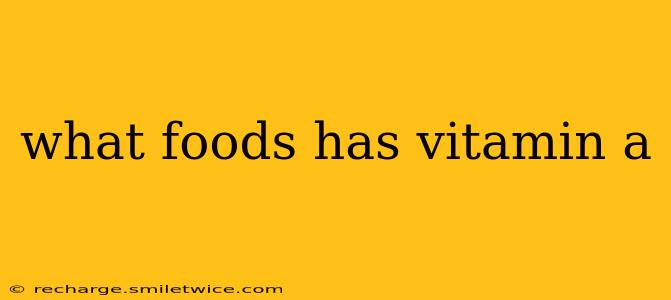What Foods Have Vitamin A? A Comprehensive Guide to Boosting Your Intake
Vitamin A is a crucial nutrient essential for maintaining good vision, supporting immune function, and promoting healthy skin and cell growth. It comes in two main forms: preformed Vitamin A (retinol) found primarily in animal products, and provitamin A carotenoids (like beta-carotene) found abundantly in plants. Understanding the difference is key to maximizing your vitamin A intake. Let's delve into the rich sources of this vital vitamin.
What are the best sources of preformed Vitamin A (retinol)?
Preformed Vitamin A is readily absorbed by the body and is easily utilized. Excellent sources include:
- Organ Meats: Liver (beef, chicken, or turkey liver) is exceptionally high in vitamin A. Just a small serving packs a significant punch.
- Dairy Products: Whole milk, cheese (especially cheddar and Swiss), and yogurt are good sources, particularly if they are made from full-fat dairy.
- Eggs: Both the yolk and the white contain vitamin A, making eggs a versatile and nutritious choice.
- Fatty Fish: Salmon, tuna, and cod liver oil are excellent sources of vitamin A, alongside other essential nutrients.
What are the best sources of provitamin A carotenoids (beta-carotene)?
Provitamin A carotenoids need to be converted into vitamin A by the body. While not as readily available, they offer potent antioxidant benefits. Excellent sources include:
- Sweet Potatoes: These vibrant orange roots are packed with beta-carotene and are a delicious way to boost your vitamin A intake.
- Carrots: A classic source of vitamin A, carrots are readily available and easily incorporated into various dishes.
- Dark Leafy Greens: Spinach, kale, collard greens, and other leafy greens are excellent sources, offering a variety of other vitamins and minerals as well.
- Apricots: Both fresh and dried apricots are a good source of beta-carotene, adding sweetness to your diet.
- Cantaloupe: This refreshing melon offers a good dose of beta-carotene along with hydration.
- Pumpkin: Both cooked pumpkin and pumpkin puree are great sources of beta-carotene and offer a versatile culinary experience.
Are there any differences between Vitamin A from animal sources and plant sources?
Yes, there are key differences:
- Bioavailability: Preformed vitamin A (retinol) from animal sources is more readily absorbed and utilized by the body than provitamin A carotenoids from plants.
- Conversion: The body must convert provitamin A carotenoids into retinol. The efficiency of this conversion varies depending on several factors, including the type of carotenoid and individual factors like gut health.
- Toxicity: While vitamin A deficiency is a serious concern, excessive intake of preformed vitamin A can be toxic. Provitamin A carotenoids are less likely to cause toxicity, as the body regulates its conversion.
What foods contain the most Vitamin A per serving?
Determining the "most" depends on whether you consider preformed Vitamin A or provitamin A carotenoids. However, organ meats (particularly liver) generally provide the highest concentration of preformed Vitamin A per serving. Among plant sources, concentrated sources like sweet potatoes and carrots often stand out due to their high beta-carotene content.
How much Vitamin A do I need each day?
The recommended daily allowance of vitamin A varies depending on age, sex, and overall health. It's best to consult a healthcare professional or a registered dietitian to determine your individual needs. They can assess your diet and health status to provide personalized recommendations.
This comprehensive guide provides a solid foundation for understanding the various sources of vitamin A. Remember to maintain a balanced diet rich in a variety of fruits, vegetables, and other nutrient-dense foods to ensure adequate intake of this essential vitamin. Consult with a healthcare professional if you have concerns about your vitamin A levels or dietary needs.
